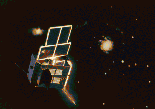|
|
EXOSAT Gas Scintillation Proportional Counter
A schematic view of the GSPC detector

Data products
The available products for the Gas Scintillator Proportional Counter
(GSPC) detector are spectra, response matrices and lightcurves.
Spectra and lightcurves were originally created, in binary
format, at the EXOSAT Observatory during the post operational phase.
HEASARC converted all EXOSAT GSPC products in FITS and generated
for each spectrum a response matrix, as well in FITS format.
GSPC data products were obtained only for those observations where
the source ME count rate was in excess of 5 count/s per half.
Sources with lower ME count rates typically do not have sufficient
signal-to-noise to justify in mean a GSPC analysis.
At HEASARC the products, in FITS format, are available from
EXOSAT gspc FTP area
on HEASARC’s archive computer.
- Lightcurves :
Background subtracted lightcurves were obtained for each source
(with sufficient signal-to-noise) in two bands, 2-8 keV and 8-15 keV,
with a time resolution of 8 seconds.
The GSPC lightcurves in FITS format make use of the FITS binary table extension
(BINTABLE). The specific FITS layout of the data is described
in the Legacy 3, 32. The total number of EXOSAT GSPC lightcurves is 1214.
HEASARC generated also GIF files (available from the
EXOSAT gspc FTP area) which show the lightcurves in the two energy band.
- Spectra and Response Matrices :
For each source there is an average background subtracted spectrum.
The average spectrum for burst sources does not include burst events.
The GSPC spectra and response matrices in FITS format make use of the FITS
binary table extension (BINTABLE). The specific FITS layout for spectra and
response matrices are described in the Legacy 2, 65 and Legacy 2, 51
respectivaly. The total number of EXOSAT GSPC spectra and response
matrices is 1330. HEASARC generated also GIF files (available from the
EXOSAT gspc FTP area) which show the spectrum convolved with
the response matrix.
A CDROM (vol2)
containing all the lightcurves, spectra and response matrices in FITS and GIF
format is available and was first distributed at the 188th AAS Meeting
(9-13 June 1996 Madison, Wisconsin).
Products naming convention
The GS product file names are a 6-character strings, a letter
followed by a 5-digit number, generated automatically by the
computer, based on the start time of the observation. The first
character, which identifies the product type, has a different convention
for the 3 experiments (LE+CMA, ME and GS), but within an
experiment different products associated with the same observation
share the 5 digit number. The GS spectra have `s' as the first
character, instead `c' and `d' are used for the lightcurves obtained
in different energy bands.
Software
- Products :
XSPEC and
XRONOS software packages are useful for analysis of the
FITS spectra and lightcurves respectivaly. The
FTOOLS package
provides also a number of programs to manipulate the FITS file.
The GIF files can be viewed on UNIX and VMS with the package xv, under
DOS with ColorView and under MacOS with Giffer.
[EXOSAT Home]
[About EXOSAT]
[Archive]
[Software]
[Gallery]
[Publications]
Page authors: Lorella Angelini Jesse Allen
HEASARC Home |
Observatories |
Archive |
Calibration |
Software |
Tools |
Students/Teachers/Public
Last modified: Tuesday, 21-Apr-2020 16:54:17 EDT
|


